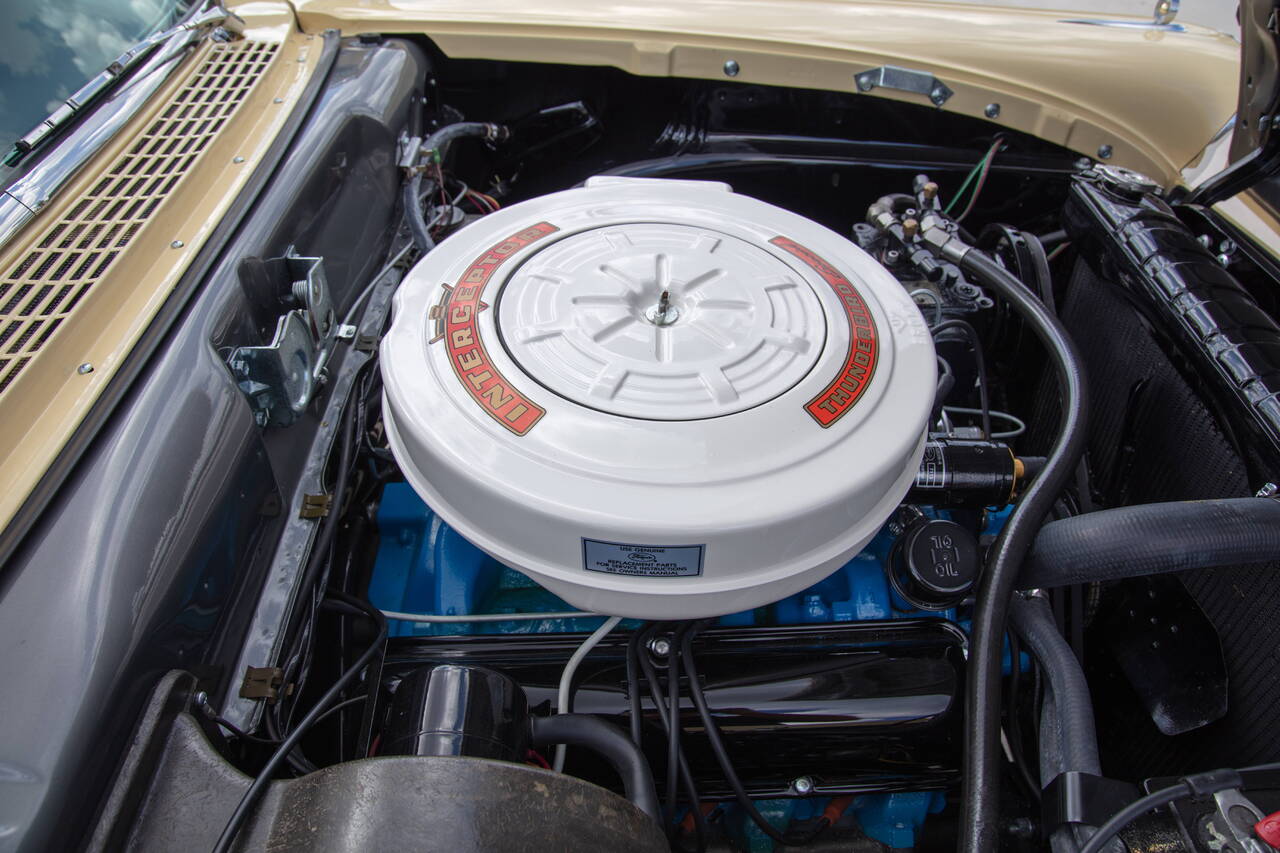

It came standard with the deep-dish steering wheel. This option was dubbed "E code" and was available in all body types. The 285 HP engine had a racing cam and was only available to NASCAR and possibly other racers.

The 270 HP version had the same cam as all the other V-8s but had vibration dampers on the valve springs. Two dual 4-barrel versions of the naturally aspirated (non-supercharged) 312 cubic inch V8 rated at 270 and 285 HP were available. The V8 lineup included a 272 CID (4.5 L) Y-block making 190 hp (142 kW), a 292 CID (4.8 L) Thunderbird version making 212 hp (158 kW), a 312 cubic inch V8 making 245 HP and a supercharged 312 CID (5.1 L) Thunderbird Special making 300 hp (224 kW), and designated "Police Interceptor" on the glove box. A new car/ pickup truck hybrid based on the short-wheelbase chassis was also introduced, the Ranchero. The two Custom lines used a 116 in (2946 mm) wheelbase, while the Fairlanes had 118 in (2997 mm) between the wheels. A plethora of trim lines was introduced, starting with the base "Custom", "Custom 300", "Fairlane", and top-line "Fairlane 500". The 1957 models retained a single-headlight front end like their predecessors, but were unmistakable with their long flanks and tailfins. The major component of this chassis was a differential whose pinion gear was exceptionally low relative to the axleshafts, lower than in conventional hypoid differentials. Wheels were now 14 inches in diameter rather the previous 15 inches, this also helped to giveĪ lower profile. The new chassis allowed the floor to be placed much lower, which in turn led to a lower and longer look overall. The Crown Victoria with its flashy chrome "basket handle" was no more, and the acrylic glass-roofed Crown Victoria Skyliner was replaced by a new model, the retracting-roof hardtop Skyliner. The mainstream Ford line of cars grew substantially larger for 1957, a model which lasted through 1959. Because of its ability to monitor individual components, OBD is able to give motorists an early warning that repairs are needed it is because of this early warning capability that OBD will sometimes fail vehicles that would otherwise pass a tailpipe test.Campbellfield, Victoria, Australia (1959 model) In such cases, other components (like the catalyst) can temporarily compensate for the part that is broken however, these other components can only do double duty for so long before they, too, begin to malfunction. Given the robust nature of today's emissions control components, it is entirely possible for an individual component to malfunction without leading to an immediate increase in emissions at the tailpipe. The OBD system looks for broken or malfunctioning emissions control components while tailpipe tests sample a vehicle's exhaust to see if it is above or below certain prescribed limits.
#1958 ford engine codes code#
OBD 2 P2832 Ford code and tailpipe testing are two different approaches to identify vehicles in need of repair. Other manufacturers sometimes use an alternating pattern in the V-engines. In the V-6 configuration, cylinder 4 is at the front right of the engine and in a V-8, cylinder number 5 is in that location. In the V-engine design, Ford follows a similar design with the number one cylinder at the front left of the engine. In-line Ford engines, along with those of most other manufacturers, begin the numbering of cylinders at the front and proceed in numerical order toward the back. The fault is most likely to be caused by the systems that the sensor is monitoring, but might even be caused by the wiring to the sensor itself.Īccelerator Pedal Position Sensor 1 Circuit Low and P2127 - Accelerator Pedal Position Sensor 2 Circuit Low would lead you to suspect a defective accelerator pedal position sensor. P2832 Ford OBD2 reports a sensor fault, replacement of the sensor is unlikely to resolve the underlying problem.


 0 kommentar(er)
0 kommentar(er)
